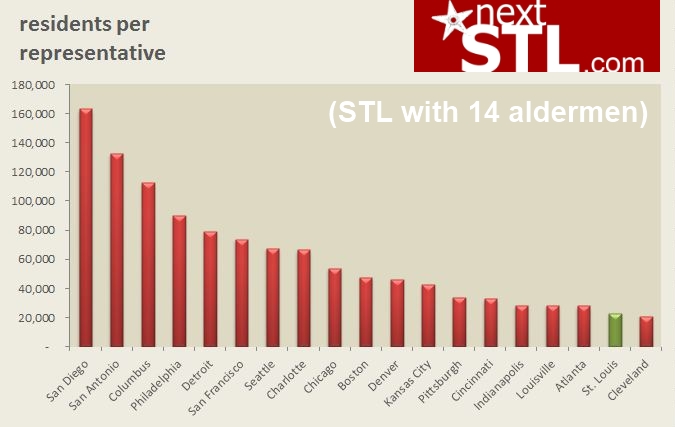 *Prop R was passed by voters in the City of St. Louis! The measure needed 77,150 of 128,583 votes cast (60%) and received 79,071, or 61.49%.
*Prop R was passed by voters in the City of St. Louis! The measure needed 77,150 of 128,583 votes cast (60%) and received 79,071, or 61.49%.
____________________
On November 6, City residents will have an opportunity to vote in favor of the first substantial political reform in St. Louis in decades. If approved by 60 percent of voters, Prop R would decrease the number of wards, and thus aldermen, from 28 to 14. Wards would be redrawn following the 2020 Census.
The exisiting system has been in place since 1914 when there were approximately 725,000 city residents. The population peaked at more than 856,000 in 1950 and is currently 319,000. Where once an alderperson represented more than 30,000 residents, that number today is near 11,000. Is this a problem in and of itself? Maybe. There’s a compelling argument to be made regarding government efficiency and service delivery. But there are larger issues at play that demand reform.
First, examples abound that city government can be run effectively and efficiently. In cities from San Antonio to Boston, locally elected city officials represent 130,000 to 50,000 residents each. St. Louis is an extreme outlier. Somehow trash is picked up, fallen trees are removed and curbs are painted in those cities. To argue that this doesn’t matter, would be to argue that the status quo has served St. Louis well. It hasn’t. Simply put, as a resident of the City of St. Louis, 27/28 of the city’s governing board doesn’t represent you.
But the real issue isn’t about having fewer aldermen simply for governing efficiency and to (presumably) lower costs. Reducing the size of the Board of Alderman is about who runs the city, who is listened to, who has a say in the future of St. Louis. With just 11,000 constituents and perhaps fewer than half that many registered voters, aldermen serve a very small constituency. With voter turnout low, keep 1,200 people happy and you remain in office. This leads to “aldermanic courtesy” as each alderperson wants to be left alone in their fiefdom and in return pledges to be absent in conversations regarding infrastructure projects, historic preservation and various development issues in the other 27 wards.
As a city resident, how likely are you to be invested in the work of an alderperson who doens’t represent you and for whom you cannot vote for or against? With 28 wards, how are you expected to follow what each alderperson does? How is the local press supposed to inform the public on the work of 28 individuals, especially when a tiny fraction of their readership is directly affected?
How likely are you to become a candidate for alderman youself? Not likely, if you’re thinking of the future of the city outside your ward. What if your alderman has served since the 1980s? Are you going to take on the challenge? Are you going to move to another ward simply to run for office? The status quo serves those in power by greatly limiting the number of individuals running for office. nextSTL will begin our “28 reasons to shrink the Board of Aldermen” soon, but these are the central issues and why it’s imperative that St. Louis begin the process of political reform.
Ballot language:
Shall the Charter of the City of St. Louis be amended in accordance with the Board of Aldermen Amendment Ordinance?
This Amendment restructures of the Board of Aldermen of the City of St. Louis as a body of 14 aldermen representing 14 wards, provides for a transition schedule to implement the restructuring, and other related matters, all as set forth in the “Board of Aldermen Amendment Ordinance,” a copy of which is available at polling places.
Follow Yes on Prop R on Twitter
Get your “Yes on Prop R” yard sign


{residents per representative if St. Louis were to have 14 aldermen}

{current residents per representative – 28 aldermen in St. Louis}

{number of aldermen if St. Louis employed the resident to representative of the cities shown}

